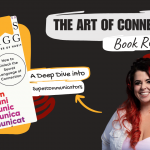Having a lot of online video meetings lately? It’s great that so many people and professionals are embracing remote technology, but what I’m hearing from my colleagues right now is a lot of frustration and burnout because people just don’t get what video meetings are all about.
When was the last time you sat in a meeting (online or in person) that easily could have been an email? On the flip side, perhaps you’ve received emails where there were so many questions or points of discussion, it’s easier to respond by jumping on a call or video meeting.
Social interaction is a basic part of being human, instinctual if you will, but most people are not naturally strong communicators. The way in which people share information with each other is often the primary factor in why a relationship or project fails or flourishes. With all the different ways we have to connect and share information with one another, it’s more important than ever to understand which type of media is best for each type of interaction.
By employing some basic strategies for the best way to communicate your message, you can make it easier for the recipient to respond and engage with you. Additionally, it helps with your own time and task management.
What to Communicate and How
I understand the extreme use of online meetings is getting to be too much for some folks, but with balance comes new hope! I’ve got a strategy to help diversify the way you communicate, so you can avoid getting “Zoomed Out”, and be even more productive along the way.
Let’s break it down by media type, and then I’ll give you the strategy for using each tool:
Chat / Text
Instant messaging is the most informal and casual of the different communication methods. These are messages that can be sent through phone text, and things like WhatsApp, Facebook Messenger, and Google Hangouts.

You’ll want to use this for communicating small amounts of information like checking in, touching base or confirming something. Although there is no character limit for these types of messages in the technology itself, you’ll want to keep all your messages short and remember to be precise. Be sure not to ask more than one question at a time, and if you’ve got multiple questions it’s best to move the conversation to an email.
It’s very easy to misinterpret tone, meaning, and phrasing in instant messaging, especially at the pace people respond. Always keep the conversation focused on one thing at a time – and try to give people the benefit of the doubt. I’ll also note here, that group messages funk up this entire dynamic altogether and I’d steer clear of those as often as possible for efficiency’s sake.
Rule of Thumb: Use text/chat for any message that takes less than 3 minutes for someone to read and respond to.
Email was once the fastest way to send a personal message, but has fallen from favor as text and instant messaging apps have taken over. Don’t count this tool out for efficiency though! Email is still the best way to convey a more detailed message, and I like to think of it as text and chat’s older, more sophisticated cousin (and a descendant of the direct letter). I have to mention before I go on, that email is not a place for information overload, and is still a place where being concise benefits everyone.

You’ll want to use email to share information too lengthy for a text or chat conversation. Email is not a great tool for discussion at all– any other method of communication listed in this article is better suited for having a discussion. This is where you can easily decipher if a meeting could be an email instead – if there is no discussion necessary and you’re only trying to convey information to people (or ask a question with a direct answer), putting it all in an email saves everyone time.
The key reason for keeping discussions out of your emails is that they can ultimately lead to arguments, which in written form can escalate quickly, and become the greatest time suck in your communication flow.
Rule of Thumb: Use email when you have a message that requires more than 3 minutes of someone’s time to read and respond to, but calls for a direct response without discussion or debate.
Phone Call (Audio Only Meeting)
Phone calls have declined in popularity against text and chat, and it’s more efficient to text versus call 9 times out of 10. BUT… the bonding power of voice to voice interaction far exceeds anything text can do. My advice: use the phone a lot more!

You’ll want to use a phone call to connect with people when you are trying to elevate that personal element in your interaction. The phone is absolutely the best way to share sensitive and emotional information, but can also be used to celebrate and recognize people when you need to make a direct connection with a person, for discussions too complex to have in the instant messaging setting, or for a meeting that lasts no more than 20 minutes (this will require you to have an agenda and stick to it).
Keep in mind that younger generations tend to avoid phone calls, and a text message before calling might be the key to connecting effectively.
Rule of Thumb: When you want to make a direct connection with someone, or have an ad-hoc meeting, pick up the phone and make the call, rather than typing a message.
Video Chat / In-Person Meeting
Now we’ve gone full circle to arrive back at the reason we’re all here – video meetings. The technology available right now is neat, fun and impressive – any excuse to use it just seems viable when you’re cooped up day after day. After reviewing all of the different options for interacting with people, you can see each tool has its specific purpose, place, and value.

Face to face communication provides the largest amount of information to pass between parties. Beyond interpreting the words themselves, you can hear tone and see facial expressions that give context to what the person is saying. This type of interaction is more time consuming than any other method. While you’re reading into all of that body language and having an interactive discussion, it’s easier to get involved in longer conversations or go off-topic altogether.
You’ll want to use video when you need to create a high-level of personal interaction, and right now, this is taking place of in-person interaction. Just like any in-person meeting, you should always have an agenda.
This is even useful for interacting with family and friends over things like Zoom and Houseparty – have a game idea or some questions in mind to bring everyone into the conversation throughout the call. Adding any kind of structure to your calls keeps them from turning into Gilligan’s 3-Hour Tour.
Rule of Thumb: Don’t use video meetings to replace things like text/chat, email, and phone calls when you don’t have to. Save the video for when you really need to “get in the same room” as someone else so the impact of that personal-level of interaction stays fresh. Keep in mind that being “in the same room” comes with all the same emotional and physical space considerations that you would normally have in-person. You are peering into someone’s private home, much like looking through a window from the outside.
Diversity Translates into Productivity
Using a diverse set of communication methods will alleviate your Zoom overload and help you become more productive. Matching the interactions you need to have with the most efficient way to accomplish them may avoid a number of unnecessary debates. Getting this right informs the people attending your meetings that you’re there with purpose.
Take some time to examine the goal of your interaction and ask yourself before you schedule that next video meeting – “Could this be an email or chat?”








Leave a Reply